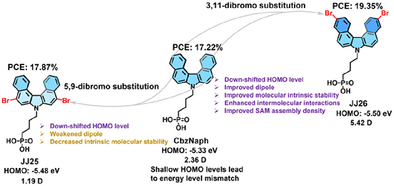Regiospecific Halogenation Modulates Molecular Dipoles in Self-Assembled Monolayers for High-Performance Organic Solar Cells
Graphical Abstract
Herein, through regiospecific bromination on a helical 7H-dibenzo[c,g]carbazole-based SAM (CbzNaph) featuring a stronger dipole, we study the properties related to intrinsic stability, electrostatic potential (ESP) distribution, and changes in the molecular dipole of the derived SAM molecules. Bromination at the chemically inert sites of 7H-dibenzo[c,g]carbazole (JJ26) helps maximize molecular dipole while maintaining superior intrinsic stability. Together with the dense assembly promoted by enhanced intermolecular interactions and synergistic effects of stronger crystallinity, JJ26 efficiently modulates the work function (WF) of indium tin oxide (ITO) and enhances the stability of SAM under external pressure. The OSC device adopting JJ26 demonstrates significantly improved performance, achieving an efficiency of 19.35% along with notably enhanced stability.
Abstract
Halogenated carbazole-derived self-assembled monolayers (SAMs) are promising hole-extraction materials in conventional organic solar cells (OSCs). While halogenation helps optimize the molecular dipole, intermolecular interactions, and energetics of SAM, the highly polarizable carbon-halogen bonds can be reactive and prone to photocleavage depending on their regiochemistry. Herein, we study the regiospecific properties, including the intrinsic stability, electrostatic potential (ESP) distribution, and changes in molecular dipole of the brominated SAM molecules by brominating a helical 7H-dibenzo[c,g]carbazole-based SAM (CbzNaph) featuring a stronger dipole. Additionally, a correlation between the intrinsic molecular stability and the derived SAM surface stability is established to determine the performance and stability of the OSCs. Notably, the bromination at the chemically inert sites of 7H-dibenzo[c,g]carbazole (JJ26) helps maximize molecular dipole while maintaining superior intrinsic stability. Together with dense assembly promoted by the synergistically enhanced intermolecular interactions and crystallinity, JJ26 can efficiently modulate the work function (WF) of indium tin oxide (ITO) and enhance the stability of SAM under external stress. Consequently, the JJ26 derived OSC shows significantly improved performance, achieving an efficiency of 19.35% along with notably enhanced stability. This work shows that the precise modulation of the regiochemistry of SAM molecules is critical for improving their quality and derived device performance.
Conflict of Interests
The authors declare no conflict of interest.
Open Research
Data Availability Statement
The data that support the findings of this study are available in the of this article.





